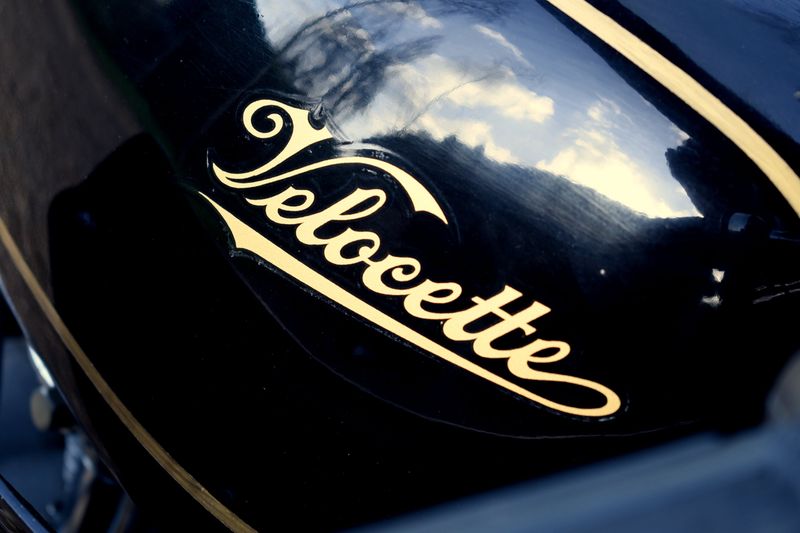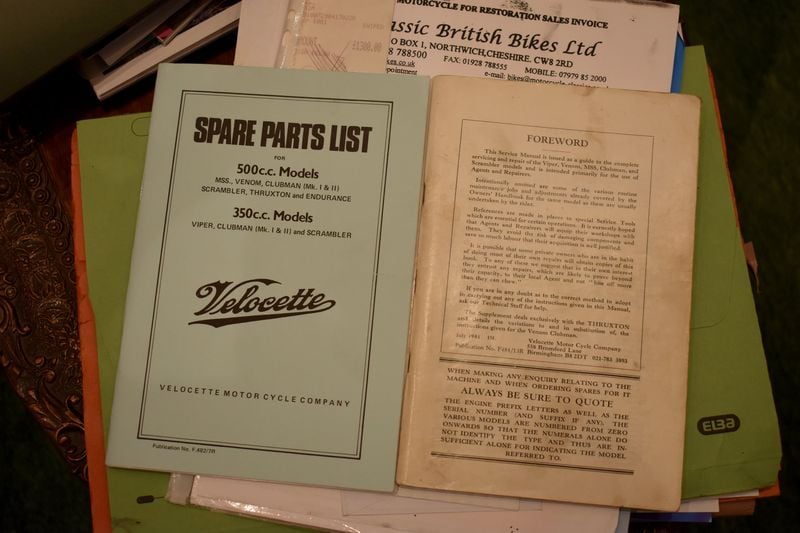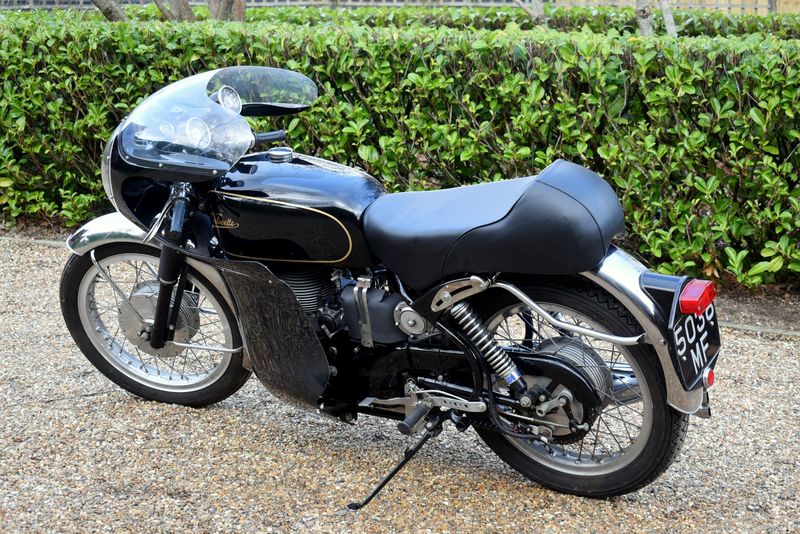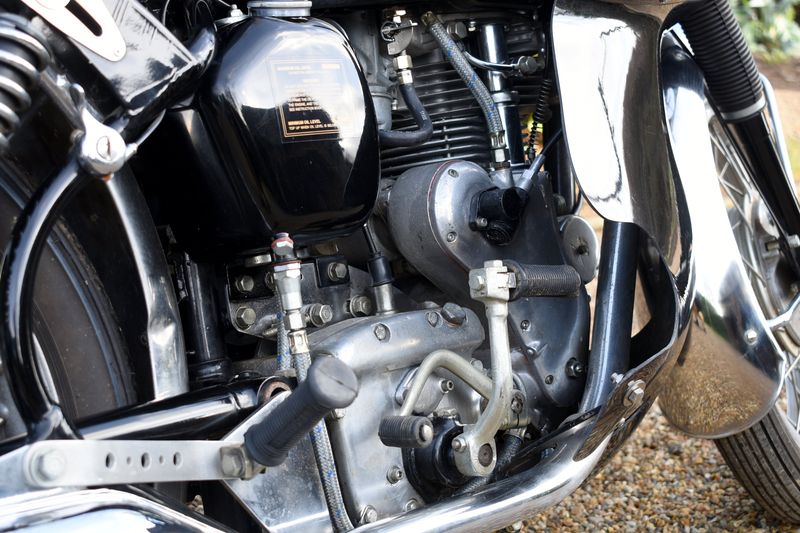Highlights
- Known ownership history from 1967 to 1969
- Extensive restoration work undertaken in the 1990s
- Only 3207 miles since restoration
- Equipped with fibreglass fairing and competition-style seat
The Background
Of all the lost British motorcycle marques, Velocette might just be the greatest loss of all. At least it went out on a high note. Right up until its final years, it had in production three of the finest motorcycles of their time, the Viper, Venom and Thruxton. Not only did they have fantastic names, they were also exceptionally good looking and possessed a competition pedigree which the consumer could be a part of to some extent with the Clubman road-racer versions of the Viper and Venom. Admittedly, they were becoming dated by the time they started being phased out from 1968, but they left a legacy to proud of.
The Venom was introduced in 1955, the 500cc sister to the 350cc Viper. Developed from the popular MSS model, it was a single-cylinder challenged with competing against the tide of new twins flooding the market. It was designed well, having a bi-metal cylinder with cast-iron liner, high-compression piston and light alloy head, while the use of a high cam and short pushrods gave it some of the characteristics of an overhead-cam engine but made it much easier to produce. Finished in black and gold with quite a lavish application of chrome, it was not only one of the best singles on the market, it was also one of the most handsome bikes anywhere.
The Venom ascended to the position of Velocette’s flagship model and sold strongly and steadily, but the best was yet to come. In 1960, the Venom Clubman appeared on the scene. With its rear-set footrests, lowered handlebars and optional fairing, it made no secret of the fact that it was bona fide racer for the road. It was mechanically upgraded, too, with Amal TT carburettors, a BTH racing magneto instead of the usual Lucas item, a close-ratio gearbox and the compression ratio increased to 9.3 to one.
It wasn’t just for show, either. On 18th March 1961, a factory-prepared Clubman with the Veeline fairing was sent to Montlhéry to have a crack at the 24-hour motorcycle world record. Not only did it succeed in going faster than anything before, it was also the first to average above the ton, ultimately completing the record at an average speed of 100.05 mph. The best lap was run at an average of 107 mph and, to this day, no other bike of the same capacity has improved upon or matched the Venom’s record. For a while afterwards, the Venom Clubman became the bike to have for any dedicated motorcycle-racing enthusiast.
The History
This Venom was first registered on 14th June 1961, issued with the Middlesex number 5038 MF. Early in its life, it migrated to Newcastle-upon-Tyne, and by 1967 it was registered to T. Cowie Ltd. of Scotswood Road, Newcastle. Thomas Stephenson Knowles Cowie established T. Cowie Ltd. as a cycle sales and repair business on Matamba Road in Sunderland prior to the war. In 1948, with peace restored, he went back to his business and moved into motorcycle sales. His business expanded rapidly so that, by 1961, there were branches in seven cities and, from 1964, it expanded into car sales.
T. Cowie sold it in 1968 to Cyril Carr of Throckley, just outside of Newcastle. He only kept it for about 10 months before handing it over to another Newcastle business, Ken’s Motor Cycles Ltd. of 246-250 Westgate Road, in March 1969. It stayed with them for a few months before finding a buyer in John Patton Little, resident in the scenic Northumberland village of Fourstones.
After its purchase by Mr. Little in July 1969, there is no further history until it is acquired by Edward Ramsay Richardson of Pelton, County Durham, in 1993. Later in the decade, it was subjected to a comprehensive restoration including a repaint, engine rebuild and much more.
A number of other owners in the north of England followed, before it ended up in the hands of the vendor, a longstanding motorcycle enthusiast and collector, a few years ago. Since its acquisition it has seen light use, and when not being ridden has occupied garage space alongside some of the finest names in British motorcycling from the 1920s to the present.
As a true enthusiast with the fullest appreciation of the motorcycles he owns, the owner enjoys riding all his machines. To that end, he does not keep them over-polished or trailer them around to shows, preferring instead to use them, with all that that entails. The vendor has taken sufficient care of his machines to ensure that they run like clockwork, start willingly and run smoothly and reliably. It is in that spirit that the Venom has been maintained, and while it may not be concours, a better-running example will be hard to find.
The vendor retains an attachment to all his bikes, but the decision to start a new life in Sweden means the collection has to be sold.
The Paperwork
The Clubman has some interesting documents on file, most important of which is its green replacement logbook documenting ownership from 1967 to 1969. There is also a recent V5 in the name the owner who purchased the bike in 2001, although it is missing an up-to-date V5.
Other documents include an overview of the works completed as part of the bike’s restoration in the 1990s and some useful factory literature such as a Service Manual and Spare Parts List. A pair of M.o.T. certificates remain on file dating from 1969 and 2002.
Other documents include an overview of the works completed as part of the bike’s restoration in the 1990s and some useful factory literature such as a Service Manual and Spare Parts List. A pair of M.o.T. certificates remain on file dating from 1969 and 2002.
The Condition
Without wanting to exaggerate, this Velocette Venom is, quite simply, sublime. The 1990s restoration has survived extremely well, with the paint appearing in excellent condition and retaining its deep shine. From any angle, the bike looks beautiful and its appearance is very much enhanced by the alloy mudguards and Brooklands-style fishtail silencer, which polish up a to a very high shine.
While the fairing appears to be a Thruxton fairing and hence incorrect for the Clubman, it is arguably better-looking than the Clubman fairing and, either way, it should not affect anyone’s enjoyment of such a beautifully-finished bike unless strict accuracy is an overriding priority.
The seat is in excellent condition, although it also appears to be of a non-original style. However, the vendor purchased a Thruxton seat in 2020 which may be fitted in its place as a more authentic alternative.
While the paint still looks fairly fresh, the metal parts such as the wheels, headstock and handlebars have a very light patina which is appropriate for their age and, we think, looks rather attractive.
The Mechanics
Having seen this bike run, we are satisfied that it is in good mechanical health (and it certainly sounds splendid). Mechanical work undertaken during its 1990s restoration was as follows:
- front wheel rebuild (stainless steel spokes) and rear wheel truth checks
- engine overhaul – new main bearings, new big-end assembly, rebore, new valves and guides, reconditioned magneto and dynamo
- new chains and sprockets
- solid state voltage regulator
- new exhaust system
- new Hagon-type rear suspension units.
Since the bike has obviously not been abused or neglected over the ensuing years, we have no reason to believe that it should not still be in an excellent mechanical state. Of course, without a current M.o.T. we cannot make any guarantees about its roadworthiness, but we’re sure it cannot need much doing to it, if anything, of any nature.
The Appeal
Most motorcyclists come to the conclusion that, short of being able to own a real racing bike, the next best thing is to build a café racer. Actually, the next best thing is to find a factory-built racing bike mildly detuned and adapted for the road. That’s assuming you can find one, as such machines were invariably restricted to low-volume production. The Velocette Venom Clubman is one such bike, though, and the one offered for sale here is to die for.
With the Thruxton fairing, it mightn’t be for the purist, but it’s still very much an enthusiast’s machine through and through. It looks phenomenal, it sounds phenomenal and, although its restoration was over 20 years ago, it’s been used so sparingly that, to all intents and purposes, it might still be considered fresh. If you want to experience post-war classic motorcycling at its very best and be the centre of attention at any bike meet for the right reasons, this is the way to go about it.
Notice to bidders
Although every care is taken to ensure this listing is as factual and transparent as possible, all details within the listing are subject to the information provided to us by the seller. Car & Classic does not take responsibility for any information missing from the listing. Please ensure you are satisfied with the vehicle description and all information provided before placing a bid.
As is normal for most auctions, this vehicle is sold as seen, and therefore the Sale of Goods Act 1979 does not apply. All bids are legally binding once placed. Any winning bidder who withdraws from a sale, is subject to our bidders fee charge. Please see our FAQs and T&C's for further information. Viewings of vehicles are encouraged, but entirely at the seller's discretion.









